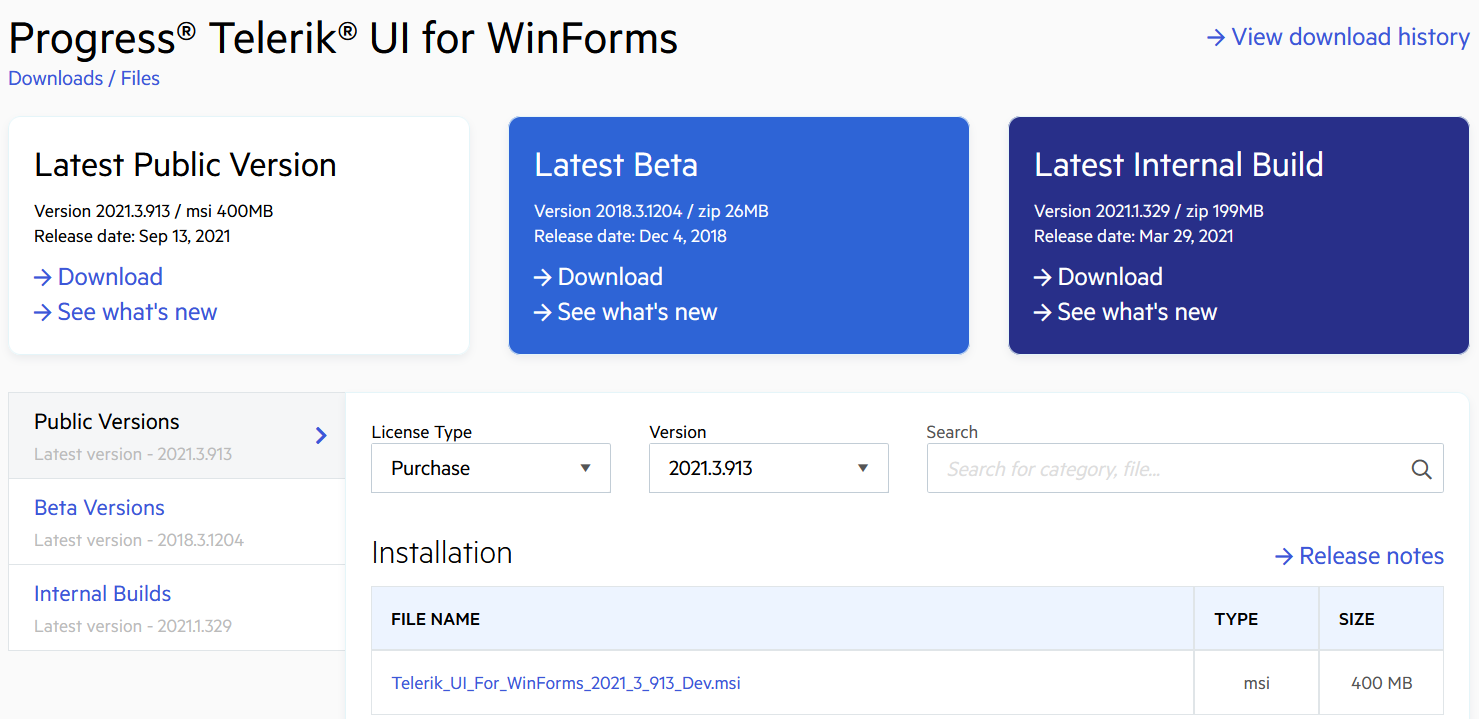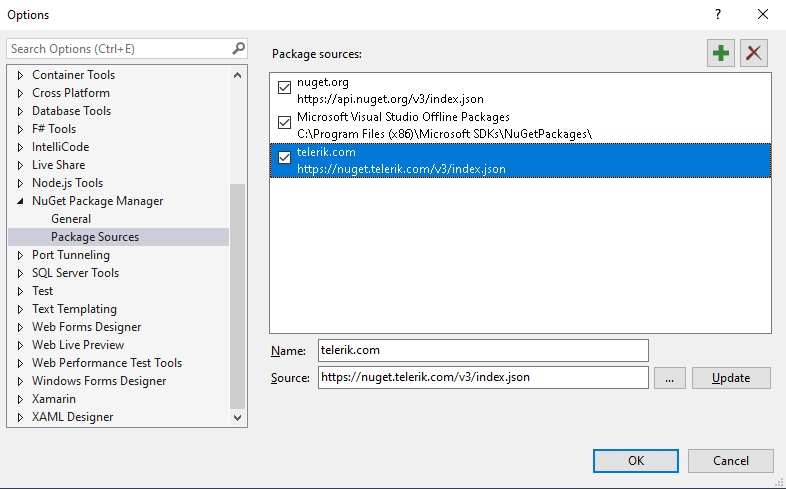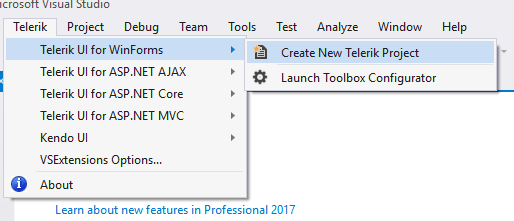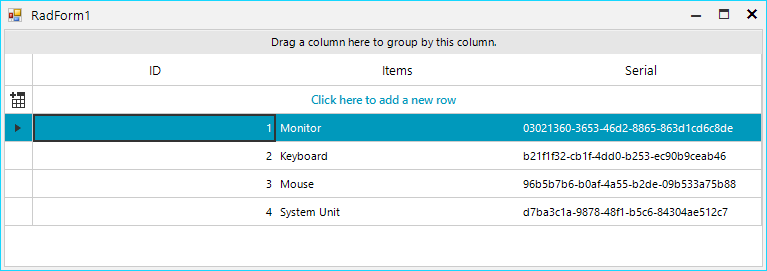First Steps with Telerik UI for WinForms
This article explains how to get the Telerik UI for WinForms controls in your project and start using them quickly. The process consists of the following steps:
- Start Your Free Trial
- Download the Controls
- Create a new WinForms Telerik Project
- Add Telerik Control to a Form
- Next Steps
Start Your Free Trial
- If you already have an active license for Telerik UI for WinForms, skip this step and continue with the next step.
-
If you don't have an active license, follow the steps below to activate your free trial:
Download the WinForms Installer and start the installation.
Make sure that Telerik UI for WinForms is selected and continue with the setup.
Log in with your Telerik account and complete the installation.
After the successful installation of Telerik UI for Winforms, the Installer activates your 30 day free trial. The installer also downloads your license key file, so you can skip the next step and continue with Create a new WinForms Telerik Project.
Download Your License Key File
To download and install your Telerik license key file:
- Go to the License Keys page in your Telerik account.
- Click the Download License Key button.
- Save the
telerik-license.txtfile to%AppData%\Telerik\telerik-license.txt.
This will make the license key available to all Telerik .NET apps that you develop on your local machine.
Download the Controls
The easiest way to get the controls to your development machine is to use the Progress Control Panel or to download the automated MSI installer from your telerik.com account.
Figure 1: Download automated (.msi) installer

If you are not a customer, you can download a free, fully functional trial and the same options will apply to you as well.
The following article provides step-by-step instructions how to install Telerik UI for WinForms on your computer: Installing UI for WinForms
Add the Telerik NuGet Server
Telerik maintains a NuGet feed with official UI for Telerik UI for WinForms releases. These packages are available for registered users with an active trial or commercial license. Adding the Telerik NuGet server as a source in Visual Studio lets you download and install Telerik packages containing controls and utilities.
As the Telerik NuGet server requires authentication, the first step is to obtain an API key that you will use instead of a password. Using an API key instead of a password is a more secure approach, especially when working with the NuGet.Config file.
Go to the API Keys page in your Telerik account.
-
Click Generate New Key +.

In the Key Note field, add a note that describes the API key.
When ready, click Generate Key.
Select Copy and Close. Once you close the window, you can no longer copy the generated key. For security reasons, the API Keys page displays only a portion of the key.
Store the generated NuGet API key as you will need it in the next steps. Whenever you need to authenticate your system with the Telerik NuGet server, use api-key as the username and your generated API key as the password.
API keys expire after two years. Telerik will send you an email when a key is about to expire, but we recommend that you set your own calendar reminder with information about where you used that key: file paths, project links, AzDO and GitHub Action variable names, and so on.
Next, add the Telerik NuGet feed to Visual Studio:
In Visual Studio and go to Tools > NuGet Package Manager > Package Manager Settings.
Select Package Sources and then click the + button to add a new package source.
Enter a Name for the new package source, for example,
telerik.com.Add the
https://nuget.telerik.com/v3/index.jsonURL as a Source. Click OK.-
Whenever Visual Studio displays a dialog to enter credentials for
nuget.telerik.com, useapi-keyas the username and your NuGet API key as the password.
Create a new WinForms Telerik Project
If you do not have a project, run the Create Project Wizard
Figure 2: Go to Telerik > UI for WinForms > Create new Telerik project

This will also automatically add 3 of the most common Telerik dll references - Telerik.WinControls, Telerik.WinControls.UI and Telerik.Common.
Add Telerik Control to a Form
The final step is to add a Telerik control to your application. As an example we will use a RadGridView control with auto generated coumns.
We will add the RadGridView control from the Toolbox. To do that simply search for RadGridView in the Toolbox and drag it to the surface of the form designer. If you do not see the Toolbox, go to View > Toolbox. Using this method will also automatically add any missing dlls to your project.
Figure 3: Add RadGridView from the Toolbox

Binding to Lists of Objects
The example below defines a MyObject class containing one integer and two string properties. The next set of code snippets "Creating an List of Objects" creates an array of MyObjects, initializes the array and assigns the array to the DataSource. The MyObject class would typically be placed in its own separate class file and the List creation, initialization and assignment code might be placed at the bottom of the form's Load event handler.
public class MyObject
{
private int id;
private string items;
private string serial;
public int ID
{
get { return id; }
set { id = value; }
}
public string Items
{
get { return items; }
set { items = value; }
}
public string Serial
{
get { return serial; }
set { serial = value; }
}
public MyObject()
{
}
}
Public Class MyObject
Private id As Integer
Private items As String
Private serial As String
Public Property ID As Integer
Get
Return id
End Get
Set(ByVal value As Integer)
id = value
End Set
End Property
Public Property Items As String
Get
Return items
End Get
Set(ByVal value As String)
items = value
End Set
End Property
Public Property Serial As String
Get
Return serial
End Get
Set(ByVal value As String)
serial = value
End Set
End Property
Public Sub New()
End Sub
End Class
List<MyObject> myList = new List<MyObject>();
myList.Add(new MyObject() { ID = 1, Items = "Monitor", Serial = Guid.NewGuid().ToString() });
myList.Add(new MyObject() { ID = 2, Items = "Keyboard", Serial = Guid.NewGuid().ToString() });
myList.Add(new MyObject() { ID = 3, Items = "Mouse", Serial = Guid.NewGuid().ToString() });
myList.Add(new MyObject() { ID = 4, Items = "System Unit", Serial = Guid.NewGuid().ToString() });
radGridView1.DataSource = myList;
radGridView1.AutoSizeColumnsMode = GridViewAutoSizeColumnsMode.Fill;
Dim myList As List(Of MyObject) = New List(Of MyObject)()
myList.Add(New MyObject() With {
.ID = 1,
.Items = "Monitor",
.Serial = Guid.NewGuid().ToString()
})
myList.Add(New MyObject() With {
.ID = 2,
.Items = "Keyboard",
.Serial = Guid.NewGuid().ToString()
})
myList.Add(New MyObject() With {
.ID = 3,
.Items = "Mouse",
.Serial = Guid.NewGuid().ToString()
})
myList.Add(New MyObject() With {
.ID = 4,
.Items = "System Unit",
.Serial = Guid.NewGuid().ToString()
})
radGridView1.DataSource = myList
radGridView1.AutoSizeColumnsMode = GridViewAutoSizeColumnsMode.Fill
For this example we also need to ensure we have reference for System; System.Collections.Generic and Telerik.WinControls.UI dlls in the RadForm1.Designer.cs.
Figure 4: Final result should look like this:

Next Steps
Now that you have the Telerik UI for WinForms controls running in your project, you may want to explore their features, customize their behavior or change their appearance. Below you can find guidance on getting started with such tasks: